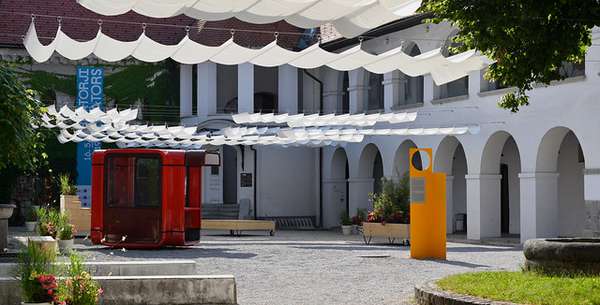Idea by
Emanuele Barili, Cosimo Balestri, Olivia Gori
ECÒL
Call for ideas 2019
Post temporary
Post temporary

- New alliances
Post Temporary is a collection of thoughts, practical problems, sociological outcomes, considerations, fears and joys linked to our experience in working with temporary architecture projects in public spaces.
Is temporary architecture the new utopia? Liberated by budget and construction permits, free to express itself in the most unusual and meaningful ways? Or is it a temporary fad at the use of quick consent and political rhetoric? Or ultimately, will there be a netflix architecture, fast, cheap and ubiquitous?
In 2018 we collaborated with the municipality of Prato, Italy in the construction of a temporary space. A retrospective analysis of the project has led us to rise some questions on the present and future use of temporary architecture in cities and on our role as architects.
Starting from the story of the Shelter n.1 project, we would like to open a discussion on the dynamics that accompany temporary architecture after its photo publication on Instagram.

The timeline offers a quick view of the steps of this temporary project, highlighting critical and controversial aspects. The diagram shows how the preliminary phases lasted a lot longer than the public space itself. Political issues, bureaucratic processes and citizens involvement consumed a lot of energies, while decreasing the duration of the project’s life span.

The area was recently purchased by the local administration to create a public park.
The participatory process (granted by the municipality and carried out by local associations) aimed to open this abandoned and unused piece of land to the citizens. While developing the public park project, the administration opened a temporary public space, giving the possibility to the people of an immediate use of this space.

During its lifespan, Shelter n.1 hosted a broad program of activities involving citizens, kids and local associations. This period corresponds to the most socially interesting and active phase of the project and is able to reveal important connotations and urban dynamics for future planning.

After the dismantling of the project, the building site went back to its original state. The structure is now stored inside a municipal warehouse, waiting for a new possible use. The area is ready to be transformed definitely, in accordance to the municipality project and design. Unfortunately neither the social dynamics, nor the physical objects will be smartly re-employed in this area.

Captured only in their peak moment, should images of temporary architecture be read as deceptive? Celebrating positive values such as social interaction and active urban planning, could their use for political propaganda become an instrument for consent? Or should they be read as the celebration of a new form of architecture? Holding the collective memory of otherwise untraceable situations and efforts.
Post temporary
Post temporary

- New alliances
Post Temporary is a collection of thoughts, practical problems, sociological outcomes, considerations, fears and joys linked to our experience in working with temporary architecture projects in public spaces.
Is temporary architecture the new utopia? Liberated by budget and construction permits, free to express itself in the most unusual and meaningful ways? Or is it a temporary fad at the use of quick consent and political rhetoric? Or ultimately, will there be a netflix architecture, fast, cheap and ubiquitous?
In 2018 we collaborated with the municipality of Prato, Italy in the construction of a temporary space. A retrospective analysis of the project has led us to rise some questions on the present and future use of temporary architecture in cities and on our role as architects.
Starting from the story of the Shelter n.1 project, we would like to open a discussion on the dynamics that accompany temporary architecture after its photo publication on Instagram.

The timeline offers a quick view of the steps of this temporary project, highlighting critical and controversial aspects. The diagram shows how the preliminary phases lasted a lot longer than the public space itself. Political issues, bureaucratic processes and citizens involvement consumed a lot of energies, while decreasing the duration of the project’s life span.

The area was recently purchased by the local administration to create a public park.
The participatory process (granted by the municipality and carried out by local associations) aimed to open this abandoned and unused piece of land to the citizens. While developing the public park project, the administration opened a temporary public space, giving the possibility to the people of an immediate use of this space.

During its lifespan, Shelter n.1 hosted a broad program of activities involving citizens, kids and local associations. This period corresponds to the most socially interesting and active phase of the project and is able to reveal important connotations and urban dynamics for future planning.

After the dismantling of the project, the building site went back to its original state. The structure is now stored inside a municipal warehouse, waiting for a new possible use. The area is ready to be transformed definitely, in accordance to the municipality project and design. Unfortunately neither the social dynamics, nor the physical objects will be smartly re-employed in this area.

Captured only in their peak moment, should images of temporary architecture be read as deceptive? Celebrating positive values such as social interaction and active urban planning, could their use for political propaganda become an instrument for consent? Or should they be read as the celebration of a new form of architecture? Holding the collective memory of otherwise untraceable situations and efforts.
